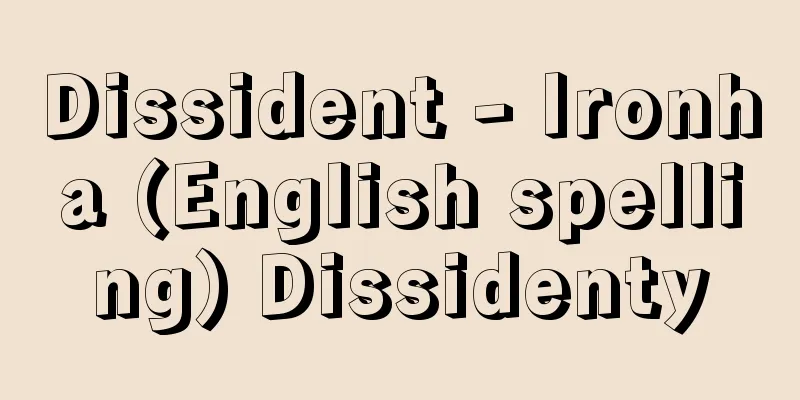Morgan Group

|
One of the largest interest groups in the United States. An international financial conglomerate that is considered to be on a par with the European Rothschild family. The founder of the Morgan conglomerate was John Pierpont (J.P.) Morgan, who established the Morgan Company, the first modern Anglo-Saxon bank in the history of American banking. The Morgan family's ancestors date back to Miles Morgan, who immigrated from Wales in England in 1636. Three generations (Joseph I to Joseph III) up to John Pierpont Morgan's grandfather lived in Hartford, Connecticut, and started out as craftsmen and farmers, and made their fortunes by expanding into coffee shops, inns, real estate, and insurance. It was John Pierpont's father, Junius Spencer Morgan (1813-90), who began working in banking. [Koichi Okumura] The Path to Financial DominanceAfter graduating from Norwich University, Junius studied finance in New York and started a financial brokerage in Boston. In 1854, he became a partner of the London-based international bank George Peabody, and after the retirement of its founder, George Peabody (1795-1869), he continued to run the bank as J.S. Morgan & Co. for 25 years. Meanwhile, Junius' son John Pierpont graduated from the University of Göttingen in Germany and joined his father's bank in 1856. He then trained at the American branch of George Peabody in New York, where he established J.P. Morgan & Co., a subsidiary of J.S. Morgan & Co. He partnered with bankers Charles H. Dabney and Anthony J. Drexel (1826-93) to build a modern banking system suited to the growth of American industrial capitalism after the Civil War. In particular, his alliance with Drexel, a leading Philadelphia financier, was effective in fighting against Jay Cooke, the largest bank at the time, which was outdated. Morgan & Co.'s largest business was the international syndicated loan of $50 million to the French government during the Franco-Prussian War in 1870, and since then, much of Britain's investment in America came through Morgan banks. With the end of the Civil War, the momentum for railroad construction increased throughout the United States. In the late 1870s, adventurous entrepreneurs such as C. Vanderbilt, J. Gould, and J. Fisk entered the railroad construction business. Morgan loaned funds imported exclusively from Europe, especially from the UK, and by the 1890s came to control many major railroad companies. Following his investment in railroad construction, he is known for forming personal and capital relationships with the Edison Electric Light Company and the Bell Telephone Company, which later developed into the giant monopolies General Electric (GE) and AT&T. In 1890, J.P. Morgan & Co. took over the business of his father Junius after his death and integrated Morgan's businesses in Europe and the United States. Investment in the steel industry began in earnest in 1898, and in 1901 he combined Carnegie Steel and Federal Steel to create the first billion-dollar company in history, U.S. Steel. Furthermore, J.P. Morgan formed a capital alliance with G.F. Baker's First National Bank and acquired H.P. Davison's Bankers Trust. Baker also owned a majority stake in the Rockefeller-affiliated Chase National Bank (the predecessor to the Chase Manhattan Bank), which gave J.P. Morgan indirect control. In 1907, J.P. Morgan also established personnel and capital ties with J. Stillman's National City Bank, completing a financial monopoly centered on Morgan. J.P. Morgan II, who succeeded John Pierpont, did not have the same entrepreneurial ambitions as his father, but he led Morgan financial capital to its peak in the 1920s, expanding its human and capital ties and lending to top companies in public utilities, railroads, steel, electrical appliances, broadcasting, and automobiles. He also expanded his underwriting of government bonds and lending to governments of various countries, including the UK, France, and Germany, and wielded the greatest influence as the king of securities and capital transactions on Wall Street, which became the center of global finance. [Koichi Okumura] Morgan's FallHowever, the Great Depression of 1929 led to growing criticism of the Morgan financial monopoly, and the 1933 Banking Act (Glass-Steagall Act) as part of the New Deal policy under the F. Roosevelt administration led to the division of J.P. Morgan & Co. into the commercial bank J.P. Morgan and the investment bank Morgan Stanley & Co. (later Morgan Stanley Dean Witter), bringing about a period of decline for the Morgan Group. Morgan's recovery after World War II began in the 1950s, when in 1959 J.P. Morgan merged with Guaranty Trust Co., a New York commercial bank, to form Morgan Guaranty Trust Co. of New York, and in 1969 the holding company J.P. Morgan was established. Thus, the Morgan Group tried to compete with the Rockefeller Group, which was at its peak in the 1960s, by forming alliances with IBM, AT&T, Merck and other high-tech companies that were on the rise, the California Group, which was focused on aerospace and military demand, the Southern Group, which was focused on oil, high-tech and military demand, and the Mellon Group (a conglomerate). As a result, by the 1980s, the investment bank Morgan Stanley had recovered to become one of the super-blue chips, a group of super-blue chips. However, by sticking too closely to the precepts of John Pierpont Morgan, "do the best business with the best customers," Morgan financial institutions were unable to capture the expanding mass market amid the financial reforms, and the growth of Morgan financial institutions slowed in the late 1990s. Then, in September 2000, nine months after the repeal of the Glass-Steagall Act in December 1999, J.P. Morgan was absorbed into Rockefeller's Chase Manhattan (the merger took place on December 31, 2000). J.P. Morgan, which had led the American financial world for over 100 years as a monopoly financial group, fell under Chase's control, and Wall Street began to evaluate this as the "fall of Morgan." However, the launch of the new company JPMorgan Chase & Co. through the merger of Chase Manhattan and J.P. Morgan can also be defined as a new global strategy for Rockefeller and Morgan through financial alliance amid the intensification of cross-border economic activity. [Koichi Okumura] "The House of Morgan: The Rise and Fall of a Financial Empire" by Ron Chernow, translated by Eiichi Aoki, Volumes 1 and 2 (1993, Nihon Keizai Shimbun) [References] | | | | | | | | | |The bank's former headquarters is located at the intersection of Wall Street and Broad Street. It was one of the most powerful banks in the United States from the late 19th century to the early 20th century. New York, USA ©NetAdvance "> Former J.P. Morgan Bank Headquarters Headquarters building on Park Avenue. J.P. Morgan merged with Chase Manhattan in 2000 to form J.P. Morgan Chase. New York, USA ©NetAdvance "> J.P. Morgan Chase Headquarters Source: Shogakukan Encyclopedia Nipponica About Encyclopedia Nipponica Information | Legend |
|
アメリカ最大の利益集団(インタレスト・グループinterest group)の一つ。ヨーロッパのロスチャイルド家と並び称される国際的な金融財閥。モルガン財閥の創始者は、アメリカ銀行史上初の近代的なアングロ・サクソン型の銀行であるモルガン商会を設立したジョン・ピアポント(J・P)・モルガン。モルガン家の始祖は1636年にイギリスのウェールズから移住してきたマイルス・モルガンにまでさかのぼる。ジョン・ピアポント・モルガンの祖父までの3世代(ジョゼフ1~3世)は、コネティカット州ハートフォードに住み、職工、農民から身をおこし、コーヒー店、旅館、不動産、保険業へと手を広げて財をなし、ジョン・ピアポントの父ジュニアス・スペンサー・モルガンJunius Spencer Morgan(1813―90)の代になって銀行業に携わり始めた。 [奥村皓一] 金融支配への道ジュニアスはノーウィッチ大学を卒業後ニューヨークで金融業を学び、ボストンで金融仲介業を始めた。1854年にはロンドンの国際取引銀行ジョージ・ピーボディの共同経営者となり、設立者ピーボディGeorge Peabody(1795―1869)の引退後は「J・S・モルガン商会」として25年間経営を続けた。 一方、ジュニアスの息子ジョン・ピアポントはドイツのゲッティンゲン大学を卒業後、1856年に父ジュニアスの銀行に入行する。その後、ニューヨークにあったジョージ・ピーボディのアメリカ支店で修行を積み、同地でJ・S・モルガン商会の子会社J・P・モルガン商会J.P. Morgan & Co.を設立した。彼は銀行家のチャールズ・H・ダブネーやアンソニー・J・ドレクセルAnthony Joseph Drexel(1826―93)とパートナーを組み、南北戦争後のアメリカ産業資本主義の成長期に適合する、近代的な銀行システムを構築した。とくにフィラデルフィアの一流金融業者ドレクセルとの同盟は、前時代的な当時最大の銀行ジェイ・クックと戦うのに有効であった。モルガン商会最大の事業は、1870年のプロイセン・フランス戦争(普仏戦争)時、フランス政府に対して5000万ドルの国際協調融資を組んだことであり、以後、イギリスの対米投資の多くはモルガン系銀行を通してなされるようになった。 南北戦争終結とともにアメリカ各地で鉄道建設の機運が高まり、1870年代末にC・バンダービルト、J・グールド、J・フィスクなど冒険的企業家が鉄道建設に進出すると、モルガンはヨーロッパとくにイギリスから独占的に輸入した資金を融資して、1890年代までに多くの主要鉄道会社を支配するに至った。鉄道建設への投資に続き、エジソン電灯会社、ベル電話会社と人的・資本的関係を結び、後の巨大独占企業ゼネラル・エレクトリック(GE)、AT&Tへと育て上げたことでも知られる。1890年、J・P・モルガン商会は父ジュニアスの没後、その事業を引き継いでヨーロッパとアメリカで展開されていたモルガンの事業を統合した。鉄鋼業への投資が本格化するのは1898年からで、カーネギー・スチールとフェデラル・スチールを結びつけて史上初の10億ドル会社USスチールを誕生させたのは1901年のことであった。 さらに、J・P・モルガンはG・F・ベーカーのファースト・ナショナル・バンクと資本提携して、H・P・デビソンのバンカース・トラストを傘下に収めた。そのベーカーはロックフェラー系のチェース・ナショナル銀行(チェース・マンハッタン銀行の前身)の過半数株式を所有していたため、J・P・モルガンの間接支配も及ぶこととなった。1907年、J・スティルマンのナショナル・シティ銀行とも人的・資本的関係を結び、かくしてモルガンを中心とした金融独占体制が完成した。 ジョン・ピアポントの後を継いだJ・P・モルガン2世は父親ほどの旺盛(おうせい)な事業欲はなかったが、1920年代のモルガン金融資本隆盛の最絶頂を築き、公益事業、鉄道、鉄鋼、電機、放送、自動車などの超一流企業への融資と人的・資本的結合を広げた。英仏独をはじめとする各国政府の国債引受けや融資も拡張し、世界の金融の中心となったウォール街の証券・資本取引の王者として最大の影響力を誇った。 [奥村皓一] モルガンの没落だが、1929年の大恐慌を機にモルガン金融独占への批判が強まり、F・ルーズベルト政権下のニューディール政策における1933年銀行法(グラス‐スティーガル法Glass-Steagall Act)で、J・P・モルガン商会は商業銀行のJ・P・モルガンと投資銀行のモルガン・スタンレーMorgan Stanley & Co.(後のモルガン・スタンレー・ディーン・ウィッター)に分割されることとなり、モルガン集団に冬の時代が訪れた。 モルガンの第二次世界大戦後における復活は1950年代からで、1959年にJ・P・モルガンはニューヨークの商業銀行ギャランティ・トラストGuaranty Trust Co.と合併し、モルガン・ギャランティ・トラストMorgan Guaranty Trust Co. of New Yorkとなり、1969年には持株会社のJ・P・モルガンが設立された。こうしてモルガン集団は、IBMやAT&T、メルクなど成長軌道にあった高度技術産業、航空宇宙・軍需を中心とするカリフォルニア集団、石油・ハイテク・軍需の南部集団、メロン集団(財閥)などとの同盟を図りつつ、1960年代に絶頂期を迎えるロックフェラー集団に対抗しようとした。その結果、1980年代までに、投資銀行のモルガン・スタンレーは、ブルーチップスblue chipsとよばれる超優良企業群の一つにまで回復した。 しかし、「最良の顧客と最良の事業を行う」というジョン・ピアポント・モルガンの教訓を貫くあまり、金融変革のさなかで拡大する大衆市場をつかめないまま、モルガン金融機関の成長は1990年代後半に減速した。そして、1999年12月のグラス‐スティーガル法撤廃から9か月後の2000年9月、J・P・モルガンはロックフェラーのチェース・マンハッタンに吸収合併されることとなった(合併期日は2000年12月31日)。独占的な金融集団として100年以上にわたりアメリカ金融界をリードしてきたJ・P・モルガンは、チェースの軍門に下り、「モルガンの没落」The fall of Morganという評価がウォール街でなされるようになった。しかし、チェース・マンハッタンとJ・P・モルガンの合併による新会社JPモルガン・チェースJPMorgan Chase & Co.の発足は、国境を越えた経済活動が活発化するなか、金融提携によるロックフェラーとモルガンの新たなグローバル戦略として規定することもできる。 [奥村皓一] 『ロン・チャーナウ著、青木栄一訳『モルガン家――金融帝国の盛衰』上下(1993・日本経済新聞社)』 [参照項目] | | | | | | | | | |ウォール街とブロード・ストリートの交差点にある旧本店。19世紀後半から20世紀初めのアメリカにおけるもっとも力のある銀行の一つであった。アメリカ ニューヨーク©NetAdvance"> 旧J・P・モルガン銀行本社 パーク・アベニューにある本社ビル。J・P・モルガンは2000年にチェース・マンハッタンと合併、J・P・モルガン・チェースが誕生した。アメリカ ニューヨーク©NetAdvance"> J・P・モルガン・チェース本社 出典 小学館 日本大百科全書(ニッポニカ)日本大百科全書(ニッポニカ)について 情報 | 凡例 |
>>: Morgagni, Giovanni Battista
Recommend
Enson (English spelling) Runddorf
A circular settlement with houses arranged in a ci...
Teika Style
The calligraphy style of Fujiwara Teika, a famous...
Zagazig
The transportation center of the Nile Delta in nor...
Bowley, AL
...I. Fisher came up with several test criteria f...
Biochemical oxygen demand - Biochemical oxygen demand
The amount of dissolved oxygen consumed by micros...
Niibo [village] - Niibo
A village in Sado County, Niigata Prefecture, loca...
Ciba-Geigy [Company] (English name) CIBA-GEIGY AG
The largest pharmaceutical and chemical manufactur...
AAA - AAA
American Arbitration Association. A private organi...
Gimje-eup
...A city on the Yellow Sea coast in the western ...
Atago Fire
〘Noun〙 A fire festival held in the Kinki and Sanin...
Kim Tae-gŏn (English spelling)
1822‐46 The first Korean priest. Born in Yongin-hy...
Gottes-dienst (English spelling)
…Finally, the fourth approach is to classify divi...
incisor
… The fourth change is the change in homodontia, ...
Ethnicity (English spelling)
An anthropological term referring to a sense of id...
free association method (English notation) free association
Free association is a research method in which con...









